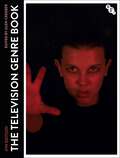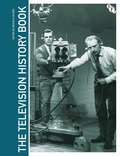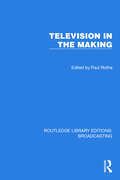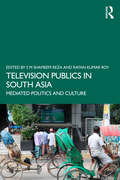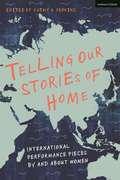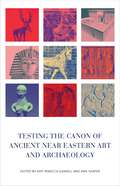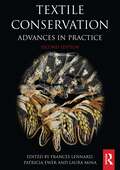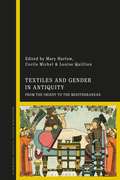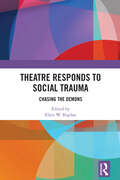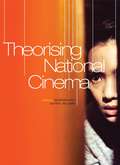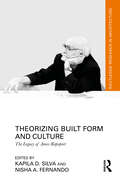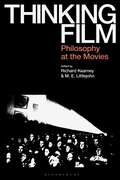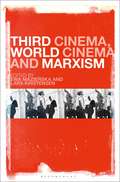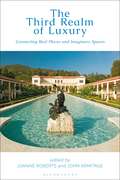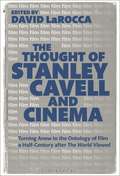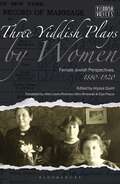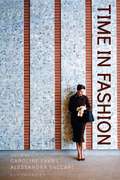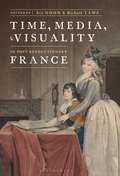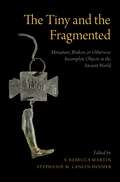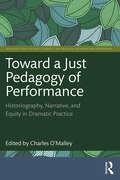- Table View
- List View
The Television Genre Book
In this new edition of The Television Genre Book, leading international scholars have come together to offer an accessible and comprehensive update to the debates, issues and concerns of the field. As television continues to evolve rapidly, this new edition reflects the ways in which TV has transformed in recent years, particularly with the emergence of online streaming services such as Netflix, Disney+, HBO Max and Amazon Prime. It also includes a new chapter on sports TV, and expanded coverage of horror, political thrillers, Nordic noir, historical documentary and docu-drama. With analyses of popular shows like Stranger Things, Killing Eve, The Crown, Chernobyl, Black Mirror, Fleabag, Breaking Bad and RuPaul's Drag Race, this book offers a comprehensive understanding of television genre for scholars and students alike.
The Television History Book
Traces the history of broadcasting and the infludence developments in broadcasting have had over our social, cultural and economic practices. Examining the broadcasting traditions of the UK and USA, 'The Television History Book' make connections between events and tendencies that both unite and differentiate these national broadcasting traditions.
Television in the Making (Routledge Library Editions: Broadcasting #37)
Television in the Making (1956) looks at television in its infancy, with essays by the leaders of the medium at the time, people who were forging new paths as they imagined and actioned the possibilities of television.
Television Publics in South Asia: Mediated Politics and Culture
Television has a prime role to play in the formation of discursive domains in the everyday life of South Asian publics. This book explores various television media practices, social processes, mediated political experiences and everyday cultural compositions from Afghanistan, Bangladesh, India, Nepal, Pakistan and Sri Lanka. With the help of country specific case studies, it captures broad range of themes which foreground the publics and their real-life experiences of television in the region. The essays in this book discuss gendered television spaces; women seeking solace from television in pandemic; the taboo in digital tv dramas; television viewership and localizing publics; changing viewership from television to OTT; news and public perception of death; re-defining ‘the national’; theatrical television; and post truth television news, among other key issues. Rich in ethnographic case studies, this volume will be a useful resource for scholars and researchers of media and communication studies, journalism, digital media, South Asian studies, cultural studies, sociology and social anthropology.
Television Sitcom and Cultural Crisis (Routledge Advances in Television Studies)
This volume demonstrates that television comedies are conduits through which we might resist normative ways of thinking about cultural crises.By drawing on Gramscian notion of crisis and the understanding that crises are overlapping, interconnected, and mutually constitutive, the essays in this collection demonstrate that situation comedies do more than make us laugh; they also help us understand the complexities of our social world’s moments of crisis. Each chapter takes up the televisual representation of a modern cultural crisis in a contemporary sitcom and is grounded in the extensive body of literature that suggests that levity is a powerful mechanism to make sense of and cope with these difficult cultural experiences.Divided into thematic sections that highlight crises of institutions and systems, identity and representation, and speculation and futurism, this book will interest scholars of media and cultural studies, political economy, communication studies, and humor studies.
Telling Our Stories of Home: International Performance Pieces By and About Women
What is home? The answer seems obvious. But Telling Our Stories of Home, an international collection of eleven plays by and about women from Lebanon, Haiti, Venezuela, Uganda, Palestine, Brazil, India, UK, and the US, complicates the answer. The "answer" includes stories as far-ranging as: enslaved women trying to create a home, one by any means necessary, and one in the ocean; siblings wrestling with their differing devotion to home after their mother's death; a family wrestling with the government's refusal to allow the burial of their soldier-son in their hometown; a young scholar attempting to feel at home after studying abroad; a young man fleeing home due to his sexual orientation only to discover the difficulty of creating home elsewhere, and Siddis (Indians of African descent) continuing to struggle for acceptance despite having lived in India for over 600 years. These are voices seldom represented to a larger audience. The plays and performance pieces range from 20 to 90-minute pieces and include a mix of monologue, duologue, and ensemble plays. Short yet powerful, they allow fantastic performance opportunities particularly in an age of social-distancing with flexible casts that together invite the theme of home to be performed and studied on the page. The plays include: The House by Arzé Khodr (Lebanon), Happy by Kia Corthron (US), The Blue of the Island by Évelyne Trouillot (Haiti), Nine Lives by Zodwa Nyoni (UK), Leaving, but Can't Let Go by Lupe Gehrenbeck (Venezuela), Questions of Home by Doreen Baingana (Uganda), On the Last Day of Spring by Fidaa Zidan (Palestine) Letting Go and Moving On by Louella Dizon San Juan (US), Antimemories of an Interrupted Trip by Aldri Anunciação (Brazil), So Goes We by Jacqueline E. Lawton (US), and Those Who Live Here, Those Who Live There by Geeta P. Siddi and Girija P. Siddi (India)
Testing the Canon of Ancient Near Eastern Art and Archaeology
Testing the Canon of Ancient Near Eastern Art and Archaeology invites readers to reconsider the contents and agendas of the art historical and world-culture canons by looking at one of their most historically enduring components: the art and archaeology of the ancient Near East. Ann Shafer, Amy Rebecca Gansell, and other top researchers in the field examine and critique the formation and historical transformation of the ancient Near Eastern canon of art, architecture, and material culture. Contributors flesh out the current boundaries of regional and typological sub-canons, analyze the technologies of canon production (such as museum practices and classroom pedagogies), and voice first-hand heritage perspectives. Each chapter, thereby, critically engages with the historiography behind our approach to the Near East and proposes alternative constructs. Collectively, the essays confront and critique the ancient Near Eastern canon's present configuration and re-imagine its future role in the canon of world art as a whole. This expansive collection of essays covers the Near East's many regions, eras, and types of visual and archaeological materials, offering specific and actionable proposals for its study. Testing the Canon of Ancient Near Eastern Art and Archaeology stands as a vital benchmark and offers a collective path forward for the study and appreciation of Near Eastern cultural heritage. This book acts as a model for similar inquiries across global art historical and archaeological fields and disciplines.
Textile Conservation: Advances in Practice (Routledge Series in Conservation and Museology)
This second edition of Textile Conservation offers an up-to-date perspective on the role and practice of textile conservators, capturing the diversity of textile conservation work across the globe.The volume considers key factors that are integral to effective conservation decision-making. It achieves this by focusing on four major factors that have influenced development in textile conservation practice over the past decades: the changing context, an evolution in the way conservators think about objects, the greater involvement of stakeholders, and technical development. Features of the new edition include: Updated chapters that explain new techniques and recent developments in the field; New and updated international case studies that demonstrate conservation decision-making in practice, including assessments of the conservation of objects in some of the world’s major cultural institutions; Full-colour illustrations that demonstrate conservation in practice. Textile Conservation will be essential reading for conservators around the world. It will also be of great interest to academics and students engaged in the study of the conservation of textiles, as well as museum and heritage professionals.
Textiles and Gender in Antiquity: From the Orient to the Mediterranean
This volume looks at how the issues of textiles and gender intertwine across three millennia in antiquity and examines continuities and differences across time and space – with surprising resonances for the modern world. The interplay of gender, identity, textile production and use is notable on many levels, from the question of who was involved in the transformation of raw materials into fabric at one end, to the wearing of garments and the construction of identity at the other. Textile production has often been considered to follow a linear trajectory from a domestic (female) activity to a more 'commercial' or 'industrial' (male-centred) mode of production. In reality, many modes of production co-existed and the making of textiles is not so easily grafted onto the labour of one sex or the other. Similarly, textiles once transformed into garments are often of 'unisex' shape but worn to express the gender of the wearer. As shown by the detailed textual source material and the rich illustrations in this volume, dress and gender are intimately linked in the visual and written records of antiquity. The contributors show how it is common practice in both art and literature not only to use particular garments to characterize one sex or the other, but also to undermine characterizations by suggesting that they display features usually associated with the opposite gender.
Theatre Responds to Social Trauma: Chasing the Demons (Routledge Series in Equity, Diversity, and Inclusion in Theatre and Performance)
This book is a collection of chapters by playwrights, directors, devisers, scholars, and educators whose praxis involves representing, theorizing, and performing social trauma.Chapters explore how psychic catastrophes and ruptures are often embedded in social systems of oppression and forged in zones of conflict within and across national borders. Through multiple lenses and diverse approaches, the authors examine the connections between collective trauma, social identity, and personal struggle. We look at the generational transmission of trauma, socially induced pathologies, and societal re-inscriptions of trauma, from mass incarceration to war-induced psychoses, from gendered violence through racist practices. Collective trauma may shape, protect, and preserve group identity, promoting a sense of cohesion and meaning, even as it shakes individuals through pain. Engaging with communities under significant stress through artistic practice offers a path towards reconstructing the meaning(s) of social trauma, making sense of the past, understanding the present, and re-visioning the future.The chapters combine theoretical and practical work, exploring the conceptual foundations and the artists’ processes as they interrogate the intersections of personal grief and communal mourning, through drama, poetry, and embodied performance.
Theorising National Cinema
Why do we think of clusters of films as 'national cinema'? Why has the relationship between the nation and film become so widely and uncritically accepted? 'Theorising National Cinema' is a major contribution to work on national cinema, by many of the leading scholars in the field. It addresses the knotty and complex relationship between cinema and national identity, showing that the nationality of a cinema production company, and the films that its made, have not always been seen as pertinent. The volume begins by reviewing and rethinking the concept of national cinema in an age of globalisation, and it goes on to chart the parallel developments of national film industries and the idea of a nation state in countries as diverse as Japan, South Korea, Russia, France and Italy. The issues of a 'national cinema' for nation states of contested status, with disputed borders or displaced peoples, is discussed in relation to film-making in Taiwan, Ireland and Palestine. The contributors also consider the future of national cinema in an age of trans-national cultural flows, exploring issues of national identity and cinema in Latin America, Asia, the Middle-East, India, Africa and Europe. 'Theorising National Cinema' also includes a valuable bibliography of works on national cinema.
Theorizing Built Form and Culture: The Legacy of Amos Rapoport (Routledge Research in Architecture)
In this collection of essays, Theorizing Built Form and Culture: The Legacy of Amos Rapoport – a felicitation volume to celebrate the significance of Professor Amos Rapoport's lifelong scholarship – scholars from around the world discuss the analytical relevance, expansion, and continuing application of these contributions in developing an advanced understanding of mutual relationships between people and built environments across cultures.Professor Amos Rapoport has espoused an intellectual and theoretical legacy on environmental design scholarship that explains how cultural factors play a significant role in the ways people create and use environments as well as the way environments, in turn, influence people’s behavior. This volume presents a hitherto-not-seen, unique, and singular work that simultaneously articulates a cohesive framework of Rapoport’s architectural theories and demonstrates how that theoretical approach be used in architectural inquiry, education, and practice across environmental scales, types, and cultural contexts. It also acknowledges, for the very first time, how this theoretical legacy has pioneered the decolonizing of the Eurocentric approaches to architectural inquiry and has thus privileged an inclusive, cross-cultural perspective that laid the groundwork to understand and analyze non-Western design traditions. The book thus reflects a wide range of cross-cultural and cross-contextual range to which Professor Rapoport’s theories apply, a general notion of theoretical validity he always advocated for in his own writings.The volume is a paramount source for scholars and students of architecture who are interested in understanding how culture mediates the creation, use, and preservation of the built environment.
Thinking Film: Philosophy at the Movies
Hailed as one of America's original art forms, film has the distinctive character of crossing high and low art. But film has done more than this. According to American philosopher Stanley Cavell, film was also a place where America in the 1930s and 1940s did its thinking, a tradition that was taken up and enriched throughout world cinema. Can film indeed think? That is, can film do the work of philosophy?Following Cavell's lead to think along the tear of the analytic-continental traditions, this book draws from both sides of the philosophical divide to reflect on this question. Spanning generations and disciplines, pondering everything from art house classics to mainstream blockbusters, Thinking Film: Philosophy at the Movies aims to fling open the doors to this conversation on all sides. Inquiring into both philosophy's word on film and film's word to philosophy, the interdisciplinary dialogue of this book traverses the conceptual and the particular as it considers how film catalyzes our thinking and sets us talking. After viewing the world through film, we find our world--and ourselves--transformed by deeper understanding and new possibilities.This book aims to provide a novel and engaging way in to thinking with and about this enduringly popular art form.
Third Cinema, World Cinema and Marxism
Third Cinema, World Cinema and Marxism offers an analysis of Third Cinema and World Cinema from the perspective of Marxism. Its starting point is an observation that of all cinematic phenomena none is as intimately related to Marxism as Third Cinema, which decries neoliberalism, the capitalist system, and the Hollywood model of cinema as mere entertainment to make money. This is largely to do with the fact that both Marxism and Third Cinema are preoccupied with inequalities resulting from capital accumulation, of which colonialism is the most extreme manifestation. Third Cinema also defines cinematic modes in terms of representing interest of different classes, with First Cinema expressing imperialist, capitalist, bourgeois ideas, Second Cinema the aspirations of the middle stratum, the petit bourgeoisie and Third Cinema is a democratic, popular cinema.
The Third Realm of Luxury: Connecting Real Places and Imaginary Spaces
In a world that is obsessed with luxury, critical luxury studies is a rapidly emerging field. This is the first book to explore the interplay between the real and imaginary realms of luxury, considering the most significant developments in the theories and practices of luxurious places and spaces over the last fifty years.Providing a critical approach to contemporary interpretations of luxury, the book interrogates the distinction between real places and imaginary spaces. Bringing together an interdisciplinary group of leading scholars, it features a range of case studies which take the reader from the Rolls-Royce Ghost Black Badge to expressions of sensuality in the 1970s domestic interior, and global conceptions of fine wine and art.The Third Realm of Luxury considers the interplay between luxury and space in both the past and the present, examining the abstract conception of excess and exoticism, as well as the real locations of the home, hotel, apartment, and palace. Full of original research, it is a key contribution to the study of consumption, design, fashion, and architecture.
The Thought of Stanley Cavell and Cinema: Turning Anew to the Ontology of Film a Half-Century after The World Viewed
Stanley Cavell was, by many accounts, America's greatest philosophical thinker of film. Like Bazin in France and Perkins in England, Cavell did not just transform the American capacity to take film as a subject for philosophical criticism; he had to first invent that legitimacy. Part of that effort involved the creation of several key now-canonical texts in film studies, among them the seminal The World Viewed along with Pursuits of Happiness and Contesting Tears. The present collection offers, for the first time anywhere, a concerted effort mounted by some of today's most compelling writers on film to take careful account of Cavell's legacy. The contributors think anew about what precisely Cavell contributed, what holds up, what is in need to revision or updating, and how his writing continues to be of vital significance and relevance for any contemporary approach to the philosophy of film.
Three Yiddish Plays by Women: Female Jewish Perspectives, 1880-1920 (Yiddish Voices)
This is an unprecedented collection of three newly translated Yiddish plays written by women in the period from 1880 to 1920. Taken together, these plays provide a fascinating insight into female Jewish perspectives on a range of women's issues prevalent at the time and, in some cases, still prevalent today. The works explore topics such as the Jewish law of the 'chained widow', pregnancy out of wedlock, and birth control, amongst many others.Three Yiddish Plays by Women includes an incisive contextual introduction which provides historical context for each individual work, summaries and discussion of the texts and stage histories for two of the three that have them. The introduction offers biographical information about each playwright and looks at what ambit they were each active in, taking into consideration gender norms. It also engages an array of recent sources and angles on intersecting questions of theater and gender in a landmark volume of vital significance to students of women's history, modern Jewish history, cultural history and theatre history.
Tightrope walker (Large Print)
This is an image of a tightrope walker standing on a rope strung between two towers and holding a long pole, which helps him balance. He is facing to the front so all his limbs are visible. There is a locator dot shown, which will be at the top left of the page when the image is the right way up. In the top centre of the page is the small image (about 5 cm high), of the tightrope walker. He is standing with his arms stretched out, holding his long pole extending to the left and right. His legs are straight and he has his feet on the wire rope, which is stretched between the towers on the left and right of the page. On the left and right of the page are two towers with a safety net, seen from the side, stretched between them. At the bottom of the page is the ground.
Tightrope walker (UEB Contracted)
This is an image of a tightrope walker standing on a rope strung between two towers and holding a long pole, which helps him balance. He is facing to the front so all his limbs are visible. There is a locator dot shown, which will be at the top left of the page when the image is the right way up. In the top centre of the page is the small image (about 5 cm high), of the tightrope walker. He is standing with his arms stretched out, holding his long pole extending to the left and right. His legs are straight and he has his feet on the wire rope, which is stretched between the towers on the left and right of the page. On the left and right of the page are two towers with a safety net, seen from the side, stretched between them. At the bottom of the page is the ground.
Tightrope walker (UEB uncontracted)
This is an image of a tightrope walker standing on a rope strung between two towers and holding a long pole, which helps him balance. He is facing to the front so all his limbs are visible. There is a locator dot shown, which will be at the top left of the page when the image is the right way up. In the top centre of the page is the small image (about 5 cm high), of the tightrope walker. He is standing with his arms stretched out, holding his long pole extending to the left and right. His legs are straight and he has his feet on the wire rope, which is stretched between the towers on the left and right of the page. On the left and right of the page are two towers with a safety net, seen from the side, stretched between them. At the bottom of the page is the ground.
Time in Fashion: Industrial, Antilinear and Uchronic Temporalities
Few phenomena embody the notion of time as well as fashion. Fast-moving and rooted in the 'now', it's constantly creating its own past through the process of rapid style change. Uniquely poised between the past and the future, fashion's relationship with time is unorthodox. Rather than considering time in the conventional sense, this anthology explores three alternative ways to think about fashion and time: the first identifies the seasonal nature of fashion as an industry, and shows how this has impacted on workers and wearers alike. The second looks at fashion design as a ceaseless process of adaptation, reconstruction and recombination of motifs, in which nostalgia and revivals play their part. The third construes fashion's 'imaginary', with its capacity for fantasy and myth-making, as a form of alternate history that asks 'what if?'Within this framework, key classic texts are juxtaposed with lesser known ones, in an interdisciplinary approach that includes philosophy, history, literature, media and fashion design, ranging from the 18th century to the present. It will be of interest to anyone wishing to understand one of the most complex yet inescapable aspects of fashion, its relationship to time, and will be a critical resource for undergraduate and postgraduate students in the humanities and all those interested in fashion in all its creative, commercial and cultural aspects.
Time, Media, and Visuality in Post-Revolutionary France
The radical break with the past heralded by the French Revolution in 1789 has become one of the mythic narratives of our time. Yet in the drawn-out afterlife of the Revolution, and through subsequent periods of Empire, Restoration, and Republic, the question of what such a temporal transformation might involve found complex, often unresolved expression in visual and material culture. This diverse collection of essays draws attention to the eclectic objects and forms of visuality that emerged in France from the beginning of the French Revolution through to the end of the July Monarchy in 1848. It offers a new account of the story of French art's modernity by exploring the work of genre painters and miniaturists, sign-painters and animal artists, landscapists, architects, and printmakers, as they worked out what it meant to be “post-revolutionary.”
The Tiny and the Fragmented: Miniature, Broken, or Otherwise Incomplete Objects in the Ancient World
Miniature and fragmentary objects are both eye-catching and yet easily dismissed. Tiny scale entices users with visions of Lilliputian worlds. The ambiguity of fragments intrigues us, offering tactile reminders of reality's transience. Yet, the standard scholarly approach to such objects has been to see them as secondary, incomplete things, whose principal purpose was to refer to a complete and often life-size whole. The Tiny and the Fragmented offers a series of fresh perspectives on the familiar concepts of the tiny and the fragmented. Written by a prestigious group of internationally-acclaimed scholars, the volume presents a remarkable diversity of case studies that range from Neolithic Europe to pre-Colombian Honduras to the classical Mediterranean and ancient Near East. Each scholar takes a different approach to issues of miniaturization and fragmentation but is united in considering the little and broken things of the past as objects in their own right. Whether a life-size or whole thing is made in a scaled-down form, deliberately broken as part of its use, or only considered successful in the eyes of ancient users if it shows some signs of wear, it challenges our expectations of representation and wholeness, of what it means for a work of art to be "finished" and "affective." Overall, The Tiny and the Fragmented demands a reconsideration of the social and contextual nature of miniaturization, fragmentation, and incompleteness, making the case that it was because of, rather than in spite of, their small or partial state that these objects were valued parts of the personal and social worlds they inhabited.
Tokens in Classical Athens and Beyond (Liverpool Studies in Ancient History)
**An Open Access edition of this book is available on the Liverpool University Press website and the OAPEN library. A selection of essays on symbola, as the tokens of Classical Athens were called, bringing together scholars of various disciplines and professional categories (numismatists, historians, museum curators) that intends to reshape our knowledge on the roles these objects played in the Athenian Democracy. This is a series of case studies which aspires to test old theories and probe new assumptions. The first section explores the extent to which our knowledge has evolved since symbola were first distinguished from coins. Four essays demonstrate how tokens, as material manifestations of particular institutions, contributed to the formation of civic and political identity in the city-state of Athens and the roles they played in ensuring legal and political equality. The second section of the volume on new finds aims to develop expertise in studying tokens and increase relevant knowledge. Finally, a third section contains comparative studies from Sicily, Jerusalem and Ephesos, aiming to adopt a comparative methodology for a better understanding of the characteristics and roles of tokens from across the ancient Mediterranean. Contributors: Vera Geelmuyden Bulgurlu, Tumay Hazinedar Coscun, Antonino Crisà, Yoav Farhi, P. J. Finglass, Mairi Gkikaki, Irini Karra, James Kierstead, John H. Kroll, Stamatoula Makrypodi, Christian Mondello, Daria Russo, Martin Schäfer.
Toward A Just Pedagogy Of Performance: Historiography, Narrative, And Equity In Dramatic Practice (Routledge Series in Equity, Diversity, and Inclusion in Theatre and Performance)
This book is a compendium of resources largely by and for artists and scholars interested in engaging in conversations of justice, diversity, and historiography in the fields of theatre and performance studies. For these students, and for the future instructors in our field who will use this book, we hold a tripartite hope: to expand, to enable, and to provide access. In its whole, we intend for this book to provoke its readers to question the narratives of history that they’ve received (and that they may promulgate) in their artistic and scholarly work. We aim to question methods and ethics of reading present in the western mode of studying drama and performance history. The contributions in the book—not traditional chapters, but manifestos, experiences, articles, conversations, and provocations—raise questions and illuminate gaps, and they do not speak in a unified voice or from a static position. These pieces are written by artists, graduate students, teachers, administrators, and undergraduates; these are expressions of hope and of experience, and not of dogma. This book is aimed toward instructors of undergraduates, both graduate students and faculty at all levels of seniority within theatre and performance studies, as well as at artists and practitioners of the art that wish to find more just ways of viewing history.
